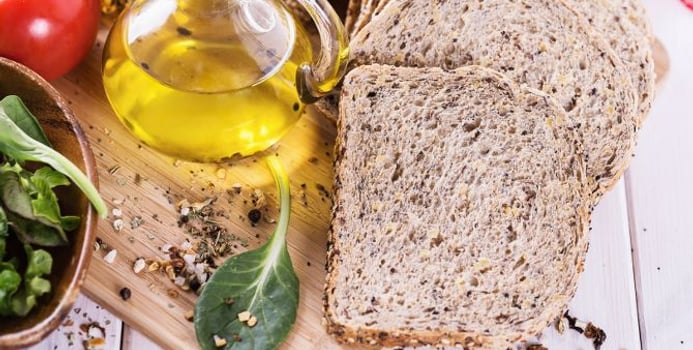Bread has been a staple food in most diets around the world and was one of earliest prepared foods known to man. It's been called the "staff of life" and the phrase to "break bread" symbolizes sharing, camaraderie and love. But is bread a dieter's worst nightmare? And if you choose to include bread in your overall healthy eating plan, what kind of bread is the most nutritious? Let's take a look at which breads will be your friends or foes when it comes to your weight management goals.
Not all bread is created equal. Whole grains and foods made from them contain all of the naturally-occurring nutrients of the entire grain seed (the bran, germ, and endosperm). Whole-grain breads are nutrient-dense, meaning they're chock-full of vitamins, minerals, fiber, protein, and phytochemicals (chemical compounds found naturally in plants that may have health benefits). Phytochemicals are found in fruits, vegetables, beans, grains and other plant foods. Refined grains (which have had the bran and germ removed during processing) are less nutrient-dense, meaning for the same number of calories, you're getting fewer health-promoting nutrients. Just because a bread or grain product claims it's "made with whole grains" or the label boasts "multi-grain" or "stone ground" doesn't mean it's 100% whole-grain.
You must look at the ingredient list. Foods made with whole grains list a whole grain, such as whole wheat, whole oats, whole corn, or brown rice, at the beginning of the ingredient list. Look for "whole" or "whole grain" before the name of the grain in the ingredient list, like "whole grain oats." Some whole grains to look for include whole wheat, wild rice, brown rice, whole oats, oatmeal, buckwheat, whole rye, whole grain corn, popcorn, bulgur, and millet. You can also look for the Whole Grains Council's 100% Whole Grain Stamp on the product.
Whole-grain bread is rich in resistant starch, a type of carbohydrate that keeps you full longer because it's difficult to digest (much like fiber, it's not completely broken down and absorbed by the body). Studies have shown resistant starch can help you curb cravings, feel full longer, and control your blood sugar. Other foods high in resistant starch include potatoes, bananas, beans, oats, bulgur, brown rice, barley, and some cereals. The World Health Organization confirms that resistant starch promotes satiety (the feeling of fullness and satisfaction) and decreases subsequent hunger. Additionally, a study done by the University of Colorado (which included more than 4,450 subjects) found that the most slender participants ate the most carbohydrates (from whole grains, fruits, and vegetables) and the heaviest subjects ate the fewest carbohydrates.
Nutritionally speaking, you want to get the most bang for your buck--meaning you should try to consume bread products that provide many nutrients but boast a relatively low calorie count. It's always important to read the nutrition facts panel, particularly looking at calories. Breads vary widely in their calorie amounts and even whole-grain breads, while always more nutritious than refined-grain breads, can have more calories than you might think. Sandwich breads can range from as low as 35 calories a slice to more than 150 calories a slice. So if you're eating two slices, as often people do when making a sandwich, you'll have to double the calorie count.
Several brands of bread that are both whole-grain and low-calorie include Healthy Life (35 calories/slice), Orowheat Light 100% Whole-Wheat (40 calories/slice),Weight Watchers 100% Whole-Wheat (45 calories/slice), and Sara Lee Delightful 100% Multi-Grain (45 calories/slice). If you're looking for something like a bun, bagel, wrap or tortilla, try these products: Arnold Select Sandwich Thins (100 calories each), Thomas' Bagel Thins (110 calories/bagel), La Tortilla Factory Smart & Delicious Low Carb/High Fiber tortillas (50 calories/small tortilla, 80 calories/large tortilla), or Flatout Light Wraps (90 calories/wrap). A brand called Joseph's makes a line of low-calorie, low-carbohydrate, high-fiber, high-protein bread products that are a tasty tool for those wishing to include bread in their diet but are worried about calories. Joseph's Flax, Oat Bran, & Whole Wheat Pita Bread clocks in at a mere 60 calories (much fewer than most pita breads) and is loaded with fiber and omega-3 fatty acids. Their Flax, Oat Bran, & Whole Wheat Square Lavash has only 50 calories a serving (1/2 a lavash), and only 100 calories if you eat the entire lavash. Their Flax, Oat Bran, & Whole Wheat Flour Tortilla has only 70 calories and 6 grams of fiber.
So go ahead, "break bread" with your friends and family and enjoy knowing you are getting essential nutrients your body needs while also sticking to your weight management goals.
Kari Hartel, RD, LD is a Registered Dietitian and freelance writer based out of St. Louis, MO. Kari is passionate about nutrition education and the prevention of chronic disease through a healthy diet and active lifestyle. Kari holds a Bachelor of Science in Dietetics from Southeast Missouri State University and is committed to helping people lead healthy lives. She completed a yearlong dietetic internship at OSF St. Francis Medical Center in Peoria, IL, where she worked with a multitude of clients and patients with complicated diagnoses. She planned, marketed, and implemented nutrition education programs and cooking demonstrations for the general public as well as for special populations, including patients with cancer, heart disease, diabetes, Alzheimer's disease, obesity, and school-aged children. Contact Kari at [email protected].



